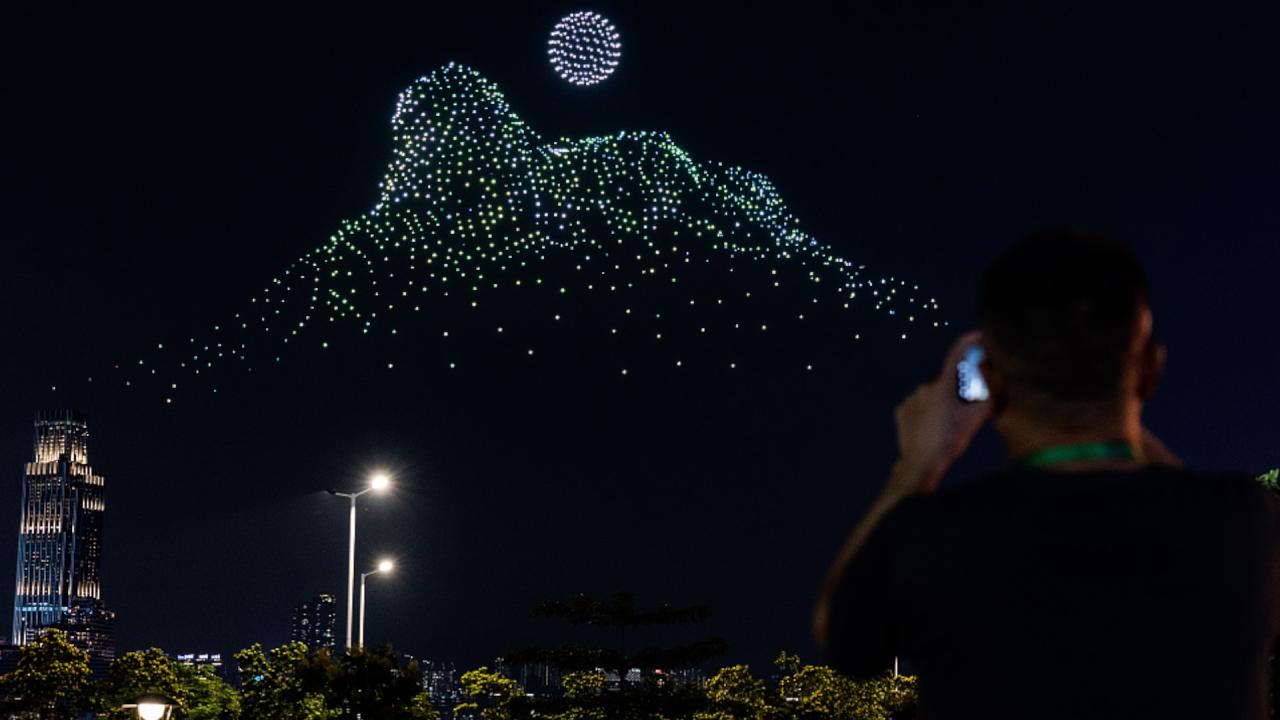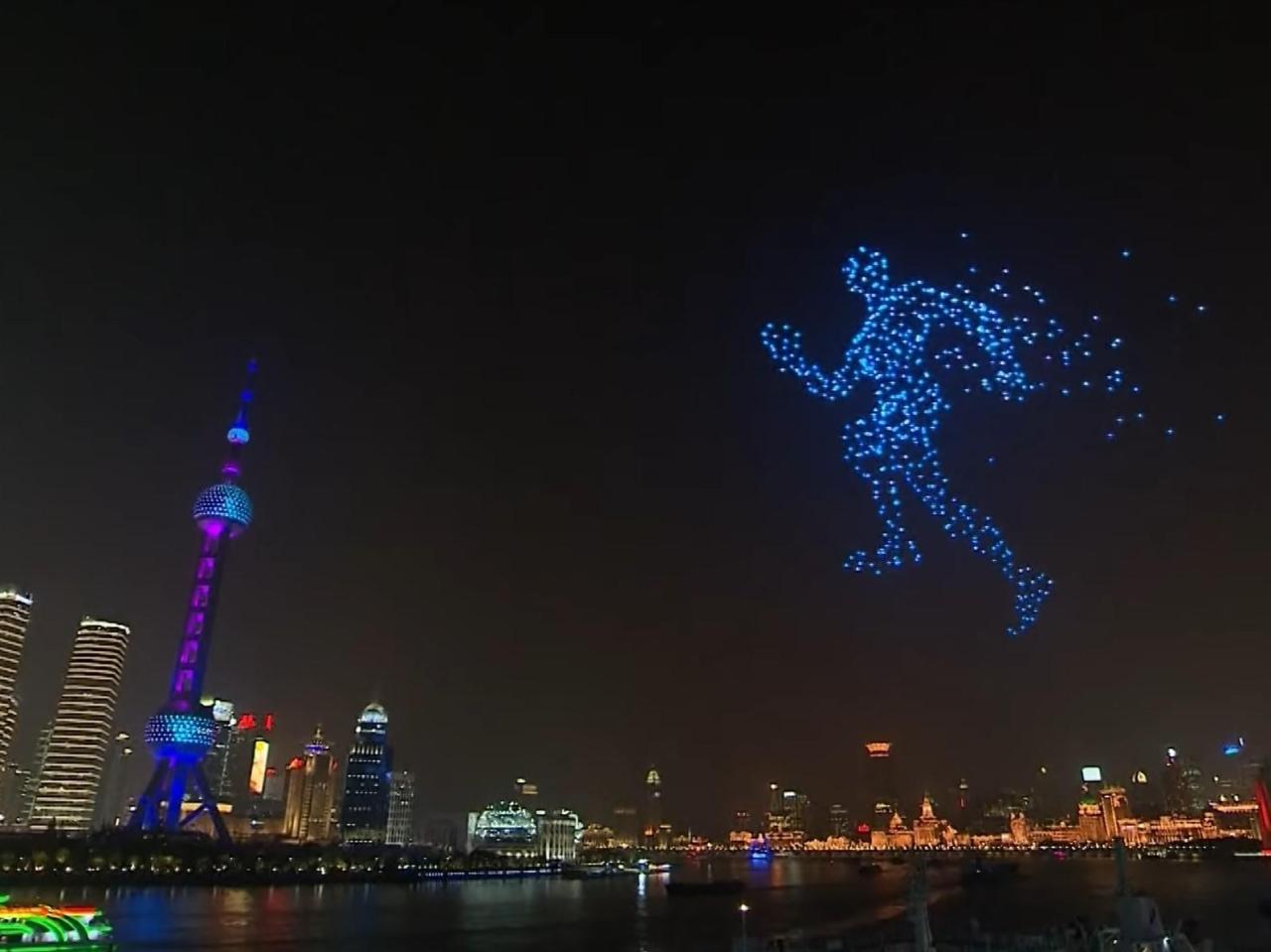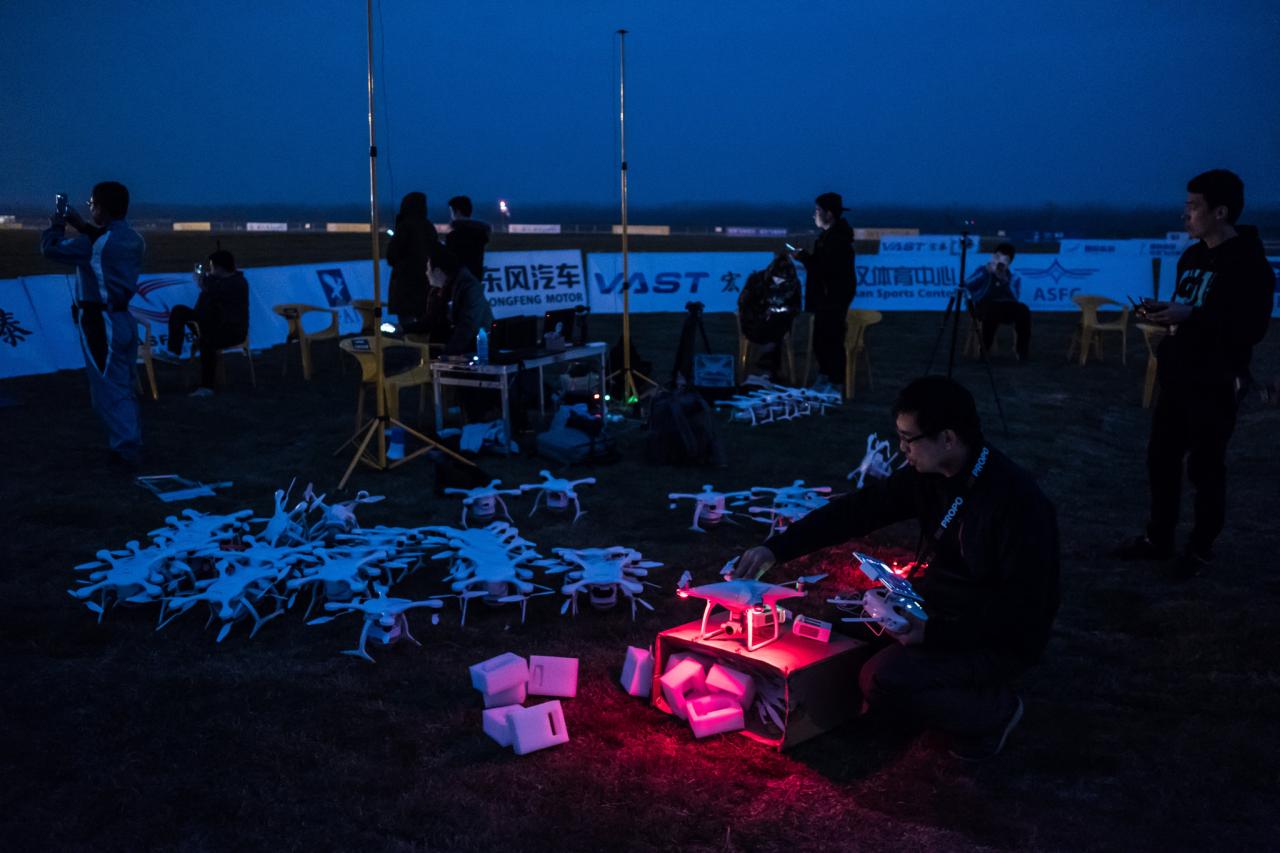China Drone Show 2066 paints a vivid picture of a future where massive, breathtaking drone displays light up the night sky. Imagine swarms of autonomous drones, crafted from advanced materials and powered by revolutionary energy sources, choreographing mesmerizing light shows above bustling Chinese cities. This isn’t just about entertainment; it’s a reflection of China’s technological prowess and its potential impact on society, the environment, and even global security.
This exploration delves into the technological leaps expected by 2066, examining the advancements in drone autonomy, materials, and power sources. We’ll also consider the societal impact, from economic benefits to cultural integration, as well as the environmental and security implications of such large-scale deployments. Finally, we’ll explore the artistic possibilities, envisioning the stunning visual spectacles these drone shows could become.
Technological Advancements in Chinese Drone Technology by 2066
By 2066, Chinese drone technology is projected to undergo a dramatic transformation, driven by advancements in artificial intelligence, materials science, and power sources. This leap will significantly impact various sectors, from entertainment to logistics and environmental monitoring.
Autonomous Flight Capabilities
Autonomous flight capabilities will be vastly improved. Drones will possess advanced AI-powered navigation systems, enabling them to navigate complex environments with minimal human intervention. Expect sophisticated obstacle avoidance, real-time path planning, and swarm coordination capabilities, allowing for complex, synchronized formations in large-scale drone shows. This will build upon current technologies like GPS and sensor fusion, incorporating machine learning for predictive modeling and enhanced decision-making.
Advancements in Drone Materials Science
Significant breakthroughs in materials science will lead to lighter, stronger, and more durable drones. The use of advanced composites, such as carbon nanotubes and graphene, will improve structural integrity and reduce weight, leading to longer flight times and increased payload capacity. Self-healing materials could also be incorporated, extending the operational lifespan of drones and reducing maintenance costs. This mirrors the current trend towards lighter and more resilient materials in aerospace engineering, but with a greater focus on cost-effectiveness for mass production.
Evolution of Drone Power Sources
The limitations of current battery technology will be addressed with the development of more efficient and higher-capacity power sources. Solid-state batteries, hydrogen fuel cells, and even advanced solar power systems are likely to power the next generation of drones. This shift will significantly increase flight endurance and reduce reliance on frequent battery changes. However, the environmental impact of these new power sources will need careful consideration, particularly regarding the production and disposal of materials.
For example, the lifecycle assessment of hydrogen fuel cells, including hydrogen production methods, will need to be carefully evaluated to minimize carbon emissions.
Comparison of Drone Capabilities
| Feature | 2024 Capabilities | Projected 2066 Capabilities | Technological Leap |
|---|---|---|---|
| Flight Time | 30-60 minutes (depending on model and payload) | 4-8 hours (with advanced power sources) | Significant increase in endurance |
| Payload Capacity | Up to several kilograms | Up to tens of kilograms | Substantial increase in carrying capacity |
| Autonomous Navigation | Basic obstacle avoidance, GPS-based navigation | Complex environment navigation, swarm intelligence, AI-powered decision-making | Transformative shift towards fully autonomous operation |
| Materials | Plastics, aluminum alloys | Advanced composites (carbon nanotubes, graphene), self-healing materials | Improved strength, durability, and weight reduction |
Societal Impact of Large-Scale Drone Shows in China (2066)
By 2066, large-scale drone shows will be a significant part of Chinese culture and economy, impacting tourism, entertainment, and even national pride.
Economic Effects on Tourism
Drone shows will become major tourist attractions, drawing significant numbers of both domestic and international visitors. This will stimulate the growth of related industries, such as hotels, restaurants, and transportation services, creating numerous jobs and boosting local economies. The economic impact can be compared to the current popularity of firework displays, but with the added technological marvel and potential for more intricate and engaging shows.
Social Impact and Cultural Acceptance
These displays are likely to become deeply integrated into Chinese culture, used to celebrate national holidays, festivals, and significant events. Public acceptance will be high, with the shows seen as a symbol of technological advancement and national pride. However, potential concerns regarding noise pollution and light pollution will need to be addressed through careful planning and mitigation strategies.
Integration into Cultural Events
Drone shows will be incorporated into major celebrations like the Chinese New Year, National Day, and other significant cultural events. The shows will be tailored to reflect specific themes and traditions, enhancing the cultural experience. For instance, the drones could depict traditional Chinese mythology, historical figures, or symbolic imagery related to the specific event.
Hypothetical Marketing Campaign
A hypothetical marketing campaign for a major 2066 drone show in Beijing could target both domestic and international tourists. Promotional strategies could include social media campaigns showcasing the show’s unique features and artistic concepts, partnerships with travel agencies, and collaborations with international media outlets. The campaign would highlight the show’s spectacular visual effects and cultural significance, creating a sense of wonder and anticipation.
Environmental Considerations of Drone Shows in 2066
While spectacular, large-scale drone shows present potential environmental challenges that require careful consideration and proactive mitigation.
Potential Environmental Risks

Large-scale drone shows could contribute to light pollution, impacting nocturnal ecosystems and potentially disrupting astronomical observations. Noise pollution from the drones themselves or accompanying sound systems could also be a concern. The manufacturing and disposal of drones and their components also pose environmental risks, demanding sustainable practices throughout the drone’s lifecycle.
Mitigation Strategies
Mitigation strategies include using low-intensity, environmentally friendly lighting systems, optimizing drone flight patterns to minimize noise, and implementing robust recycling programs for drone components. Furthermore, shows could be timed to minimize disruption to wildlife and astronomical observations.
Comparison with Other Events
Compared to traditional firework displays, drone shows offer a potentially more environmentally friendly alternative, reducing air pollution and waste. However, the energy consumption and potential for light and noise pollution still need careful management to minimize their environmental footprint.
Potential Environmental Regulations

- Limits on the intensity and duration of lighting during shows.
- Noise level restrictions to protect wildlife and nearby communities.
- Mandatory use of sustainable materials in drone construction.
- Regulations on drone disposal and recycling.
- Environmental impact assessments required before permits are issued.
Security and Safety Aspects of Massive Drone Deployments
The safety and security of large-scale drone shows require robust protocols and contingency plans to prevent and manage potential incidents.
Security Vulnerabilities and Countermeasures
Potential security vulnerabilities include hacking or malicious control of drones, causing them to malfunction or behave unpredictably. Countermeasures include advanced cybersecurity systems, encryption protocols, and redundancy in drone control systems. Regular security audits and penetration testing are crucial to identify and address vulnerabilities before a show.
Safety Protocols and Emergency Response

Comprehensive safety protocols and emergency response plans are essential. These should include measures for handling drone malfunctions, battery failures, or other unexpected events. Trained personnel should be on standby to address any incidents quickly and efficiently. This could involve a dedicated drone safety team with specialized equipment and expertise.
Safety Record Comparison, China drone show 2066
The safety record of drone shows in 2066 is projected to be significantly better than current standards due to advanced technologies and stringent safety protocols. This will involve a proactive approach to safety, including rigorous testing, simulation, and continuous improvement based on data analysis.
Hypothetical Incident and Resolution
Imagine a scenario where a single drone malfunctions during a large-scale show, causing it to deviate from its programmed flight path. The incident response team immediately isolates the malfunctioning drone using a remote kill switch, preventing it from colliding with other drones or causing harm. The show is briefly paused while the situation is assessed and resolved, then resumes after confirming the safety of all remaining drones.
The Artistic and Creative Potential of Drone Shows in 2066
Drone shows in 2066 will be a breathtaking spectacle of light, sound, and motion, pushing the boundaries of artistic expression.
Evolution of Choreography and Artistic Expression
Choreography will be far more complex and sophisticated, utilizing advanced AI algorithms to generate intricate and dynamic formations. The shows will incorporate elements of storytelling, music, and dance, creating immersive and emotionally engaging experiences. Think of it as a fusion of traditional Chinese performance arts with cutting-edge technology.
Integration of Other Technologies
Augmented reality (AR) will be seamlessly integrated, enhancing the visual experience for spectators. AR applications could overlay digital imagery onto the drone formations, creating a blended reality that blurs the lines between physical and virtual worlds. Imagine dragons soaring through the night sky, only to reveal themselves as a sophisticated drone formation when viewed through AR glasses.
Innovative Artistic Concepts
Drone shows could recreate famous paintings or sculptures in mid-air, tell stories through dynamic formations, or create interactive experiences where the audience influences the show’s progression. The possibilities are limited only by the imagination of the artists and the capabilities of the technology.
Visual Description of a Hypothetical Drone Show

Imagine a breathtaking drone show over the Forbidden City in Beijing. Thousands of drones, each equipped with customizable LED lights, form a mesmerizing tapestry of color and light. They shift and morph, depicting scenes from Chinese history and mythology – the Great Wall snaking across the sky, mythical dragons swirling in graceful formations, and phoenixes taking flight. The drones’ lights interact with the city’s illuminated buildings, creating a vibrant, three-dimensional spectacle that captivates the audience with its sheer scale and artistic brilliance.
A synchronized soundscape, composed specifically for the show, enhances the emotional impact, creating a truly unforgettable experience.
Closing Notes
The China Drone Show 2066, as envisioned, presents a compelling blend of technological marvel, artistic expression, and societal impact. While challenges remain in addressing environmental concerns and ensuring safety and security, the potential benefits—from economic growth to cultural enrichment—are immense. The future of drone technology in China promises not only spectacular shows but also a transformation across various sectors, showcasing innovation on a grand scale.
Query Resolution: China Drone Show 2066
What types of new materials might be used in drones by 2066?
We might see drones constructed from lighter, stronger, and more durable materials like advanced carbon composites, bio-inspired materials, or even self-healing polymers.
How will drone shows be regulated to minimize environmental impact?
Regulations could include noise level limits, restrictions on show duration and frequency, designated show locations, and specific lighting guidelines to reduce light pollution.
What are the potential security risks of large-scale drone deployments?
Risks include hacking, unauthorized access, and the potential for drones to be used maliciously, requiring robust cybersecurity measures and strict control systems.
What new artistic techniques might be incorporated into drone shows?
Expect to see more complex formations, integrated augmented reality experiences, interactive elements responding to audience participation, and perhaps even AI-driven choreography.
